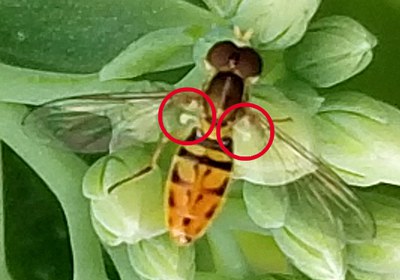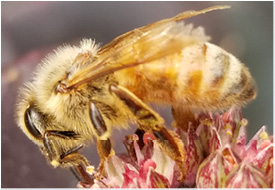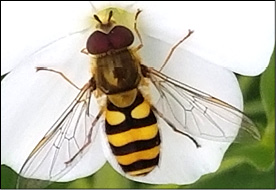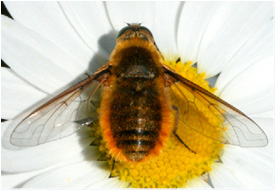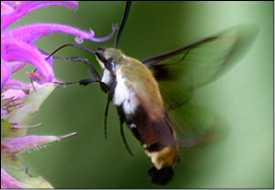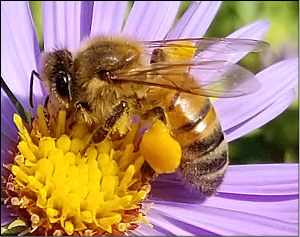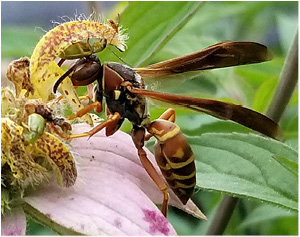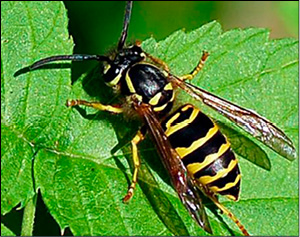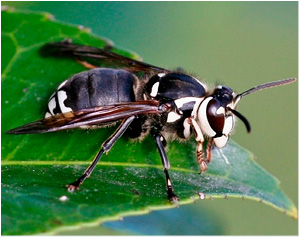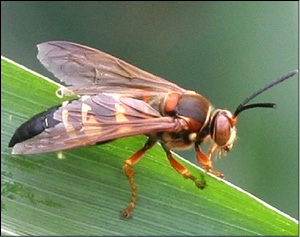Wasps appear less hairy than most bees (Figures 2 and 6). Using a microscope, you can see the hairs of wasps are simple (not branched), while hairs of bees are branched. Most bees have special pollen-collecting hairs or baskets on their hind legs (Figure 6). Leafcutter bees collect and carry pollen on hairs underneath their abdomens.
Figure 6. Honey bee collecting pollen from aster flower. Note the pollen basket on its hind legs.
Both wasps and bees have four developed wings and two long segmented antennae. Wasps also have an elongated body with a distinctly visible narrow “waist” (Figure 7), a constriction between the thorax and abdomen. In contrast, bees have a more robust body and the waist is not readily visible. The colors and patterns of wasps are typically brighter and more diverse than bees.
Figure 7. Paper wasp. Note the waist between the thorax and abdomen.
Paper wasps, yellowjackets and bald-faced hornets are social wasps that nest in colonies, and frequently visit and pollinate flowers. Another benefit of these wasps is that they are important predators of caterpillars (or insect pests) in gardens.
Paper wasps (Family: Vespidae) (Figure 7) are approximately 1 inch long, with black, yellow, brown or sometimes orange markings. Their paper nests occur in sheltered areas, such as under house eaves, inside open pipes or tree branches. Paper wasps are not as aggressive as yellowjackets and bald-faced hornets, and only attack if they or their nest is threatened.
Yellowjackets or hornets (Family: Vespidae) (Figure 8) are approximately ½ to 1 inch long, with a yellow face except for the black eyes, black antennae, and yellow and black bands on the abdomen. Yellowjackets usually nest in the ground and will defend their nest aggressively.
Figure 8. Eastern yellowjacket.
Bald-faced hornets (Family: Vespidae) (Figure 9) are about ¾ to 1 inch long, and have black with light yellow to white markings and a white tip at the end of abdomen. Their large paper nests are easy to see in tree limbs and sometimes in roof peaks. Bald-faced hornets are very aggressive and sting repeatedly if you get too close to their nest.
Figure 9. Bald-faced hornet.
Cicada killers (Family: Crabronidae) (Figure 10) are solitary wasps and large (¾ to 2 inches long) with a yellow face, red eyes and a black abdomen with yellow bands. Wings are brown and legs are red. Most solitary wasps have a short tongue, so they prefer flowers with shallow nectar reserves.
Figure 10. Cicada killer wasp.
As its name implies, the Cicada killer preys on cicadas, and then provisions its nests with the prey as a food source for developing larvae. These wasps do not have the “nest guarding” instinct of other wasps and bumble bees. Although cicada killers are not aggressive, females do have stingers and can sting when threatened.
This publication is supported in part by the Crop Protection and Pest Management Program [grant No. 2017-70006-27144/accession 1013592] from the U.S. Department of Agriculture’s National Institute of Food and Agriculture. Any opinions, findings, conclusions or recommendations expressed are those of the authors and do not necessarily reflect the view of the USDA.
